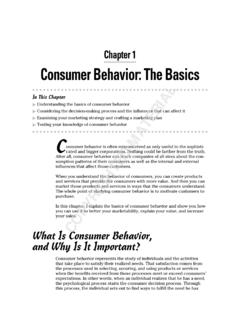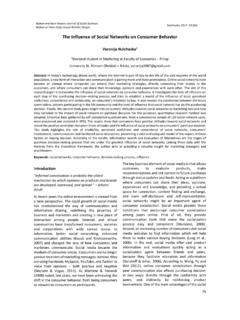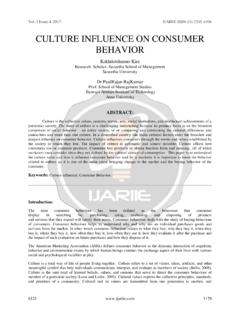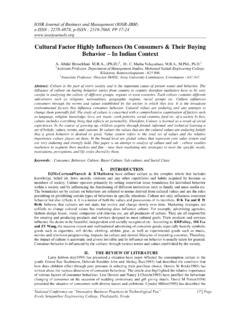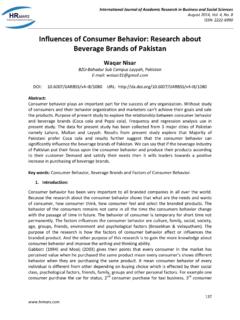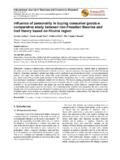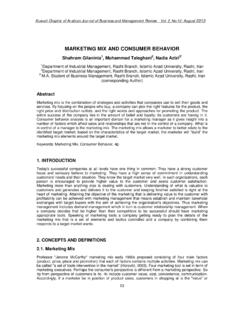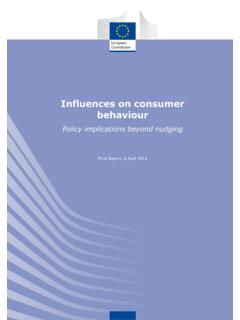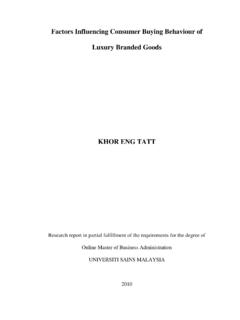Transcription of Inluence of Tobacco Marketing on Smoking Behavior
1 7 Influence of Tobacco Marketing on Smoking Behavior The relationship between Tobacco Marketing and Smoking Behavior , particularly among adolescents, has been extensively researched. This chapter examines the evidence base for how these Marketing efforts affect initial uptake and continued use of Tobacco by adolescents and by the general population. Data from a multitude of studies using a range of methodologies were examined along with Tobacco industry source documents in assessing the role of Marketing in Tobacco use.
2 Specific areas discussed include n The relationship between cigarette Marketing and identifiable adolescent needs, such as peer acceptance, rebelliousness, risk taking, and stress relief n The impact of cigarette Marketing on adolescents self-images and their perceptions of smokers n The effects of exposure to cigarette Marketing on adolescent Smoking n The relationship between Tobacco Marketing expenditures and Tobacco consumption in the general population, including time-series and cross-sectional studies, as well as studies of the impact of advertising bans on consumption and use Numerous studies find a strong connection among advertising exposure, adolescent initiation to Tobacco use, and progression to regular Tobacco use.
3 Cross-sectional econometric studies also show a correlation between Tobacco advertising and increased cigarette consumption. As a whole, the evidence base indicates a causal relationship between Tobacco advertising and increased levels of Tobacco initiation and continued consumption. 211 7 . I n f l u e n c e o f T o b a c c o M a r k e t i n g o n S m o k i n g B e h a v i o r Introduction Although the Tobacco industry has asserted that its Marketing efforts are not aimed at creating new demand but rather at increasing brand market share, internal industry documents contribute to the evidence refuting this claim.
4 The ability of Tobacco Marketing to create new demand by encouraging Smoking initiation among youth and adults is a critically important aspect of the role of the media in Tobacco use. Researchers have studied whether the level of Tobacco advertising is related to aggregate cigarette demand: When exposed to high levels of Tobacco industry Marketing , do more people start using Tobacco , do smokers smoke more, and are they less likely to quit? Alternatively, would the absence of cigarette advertising have the opposite effect?
5 This chapter reviews evidence of the influence of cigarette Marketing on adolescent Smoking initiation many start to smoke before the legal age for purchasing cigarettes1 and on cigarette consumption in the general population. Other chapters in this monograph review advertising theory (chapter 2), types and extent of Tobacco advertising and promotions (chapter 4), themes and targets of Tobacco advertising (chapter 5), and media influences in preventing and controlling Tobacco use (chapter 12). For a discussion of the effects on adolescent Behavior of the depiction of Smoking in movies, see chapter 10.
6 Below is a brief overview of the topics covered in the main sections of this chapter. Three lines of evidence regarding adolescent Smoking are considered. The first includes literature describing adolescent psychological needs and how Tobacco Marketing suggests that Smoking can help satisfy these needs. Subsections under the main heading of adolescent needs show that adolescents have such needs, cigarette Marketing communicates to them that Smoking will help fulfill these needs, and that adolescents who smoke or who do not rule out Smoking in the future are more likely to believe that Smoking can fulfill these needs.
7 Of course, Marketing for many other products also aims to convince adolescents that product use can help satisfy these needs. The second related line of evidence focuses on development of self-image during adolescence2 and involves many factors, such as popularity, masculinity/femininity, rebelliousness, acceptance by peers, confidence in interacting with others, and so forth. For example, a boy who feels he is masculine and rugged is a little more confident in interactions with others. If his peers see him in this way, he is more likely to gain admiration from others.
8 If he perceives that Smoking can bolster this image, he may more readily adopt this Behavior . Further, there is evidence that those with personal images similar to the images they have of smokers will be more prone to smoke. The third line of evidence measures exposures of adolescents to Tobacco advertising and promotions and any association between those exposures and Smoking Behavior , including the likelihood of future Smoking . First, methodological issues including study design, measures of Smoking Behavior , and measures of exposures and receptivity to cigarette advertising and promotions are described.
9 Then, this section reviews the evidence that these measures are associated with higher levels of both intentions to smoke and actual Smoking in both cross-sectional and longitudinal studies. A final section of this chapter addresses various types of time-series studies that relate the level of Tobacco Marketing expenditures to population-based cigarette consumption. It also discusses studies 212 M o n o g r a p h 1 9.
10 T h e R o l e o f t h e M e d i a that correlate novel advertising and promotional campaigns with changes in the incidence of adolescent Smoking initiation and brand preference. For the review of research on the relationship between cigarette advertising and promotions and adolescent Smoking Behavior , the American Psychological Association s PsycINFO database3 was searched for the period from index inception in 1809 to May 2007. Three search terms Marketing , Tobacco , and teenagers were combined for each search using as many forms of each word as possible, such as singular and plural, synonyms, shortened forms, and so on.




